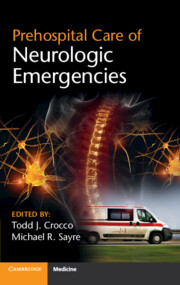Book contents
- Prehospital Care of Neurologic Emergencies
- Prehospital Care of Neurologic Emergencies
- Copyright page
- Dedication
- Table of contents
- Contributors
- Preface
- Chapter 1 Lightheadedness and dizziness
- Chapter 2 Headache
- Chapter 3 Seizures
- Chapter 4 Stroke and transient ischemic attack
- Chapter 5 Spinal cord injury
- Chapter 6 Traumatic brain injury
- Chapter 7 Altered mental status
- Index
Chapter 1 - Lightheadedness and dizziness
Published online by Cambridge University Press: 05 August 2014
- Prehospital Care of Neurologic Emergencies
- Prehospital Care of Neurologic Emergencies
- Copyright page
- Dedication
- Table of contents
- Contributors
- Preface
- Chapter 1 Lightheadedness and dizziness
- Chapter 2 Headache
- Chapter 3 Seizures
- Chapter 4 Stroke and transient ischemic attack
- Chapter 5 Spinal cord injury
- Chapter 6 Traumatic brain injury
- Chapter 7 Altered mental status
- Index
Summary
- Type
- Chapter
- Information
- Prehospital Care of Neurologic Emergencies , pp. 1 - 17Publisher: Cambridge University PressPrint publication year: 2014

